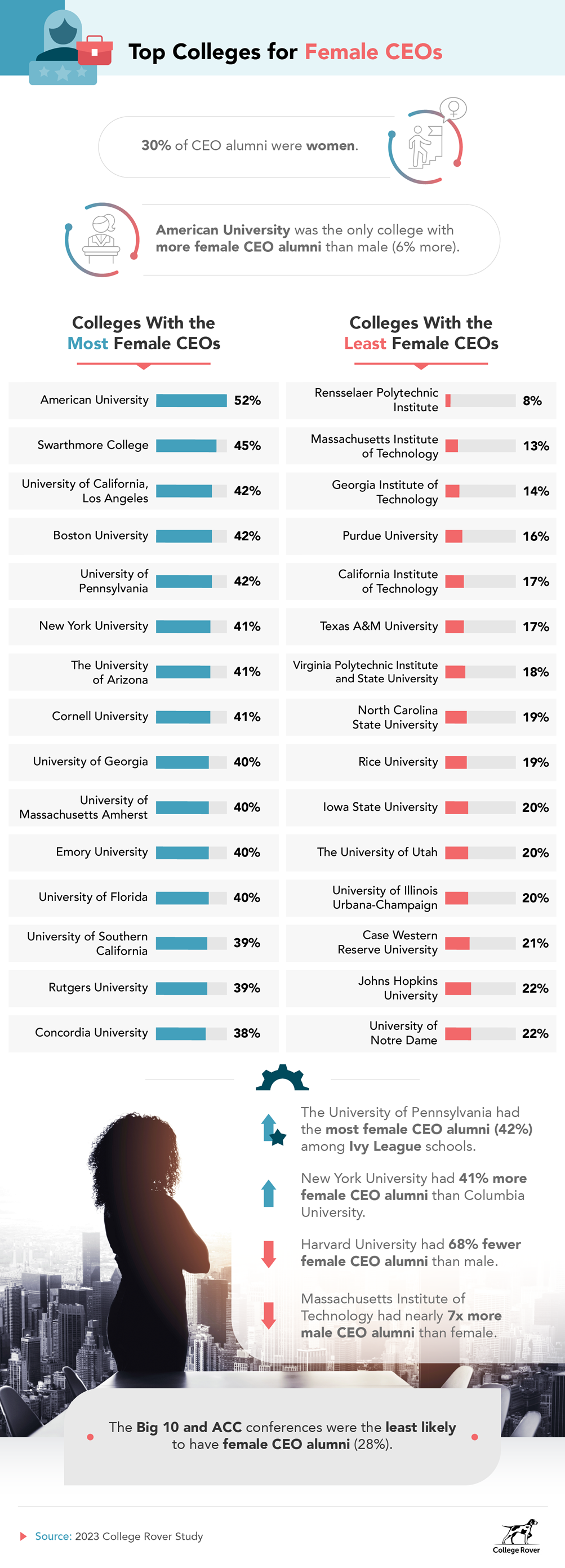Key takeaways
- Babson College has the most CEOs per 10,000 alumni (1,091), followed by Stanford University (759).
- Iowa State University has the least CEOs per 10,000 alumni (111).
- The top three colleges to produce female CEOs are American University (52%), Swarthmore College (45%), and The University of California, Los Angeles (42%).
- American University is the only college with more female CEO alumni than male (6% more).
The powerhouses of CEO production
It's a long journey to the top, but Chief Executive Officers (CEOs) often have a great foundation to get started-a college education. College can give future CEOs a basic knowledge of business, management, and their particular field of expertise, as well as time management, communication, and leadership skills. But do all colleges and universities equally prepare graduates for the CEO track?
For this study, we used data from LinkedIn to examine the number of CEOs among alumni from 99 major U.S. colleges and universities. This article will uncover the colleges producing the most CEOs overall and take a focused look at the colleges and universities actively supporting future female CEOs.
Forging a legacy of leadership
People often assume you need an Ivy League education to rise to the top of the business ranks, but what our study discovered might surprise you.

Babson College emerged as the undisputed champion in CEO production, with 1,091 CEOs per 10,000 alumni. Babson is a private business school located in Massachusetts, and it produced over 300 more CEOs per 10,000 alumni than the next closest school. Following Babson were two of the best colleges in California: Stanford University, with 759 CEOs per 10,000 alumni and the University of California San Diego, with 727.
Only one of the top 5 schools for CEOs were in the Ivy League, Cornell University, with 492 CEOs per 10,000 alumni. Cornell University was the top Ivy League producer, with 492 CEOs per 10,000 alumni. That said, our study found that CEOs were 11% more likely to attend a public institution than a private one.
On the other end of the list, Iowa State University produced the fewest CEOs at just 111 per 10,000 alumni. Texas A&M University and Oregon State University rounded out the bottom three, with 129 and 131 CEOs per 10,000 alumni, respectively.
.png)
While no individual Ivy League school ranked among the top 5 CEO producers, the conference as a whole overshadowed the rest of the field. With a combined 414 CEOs per 10,000 alumni, the Ivy Leagues was the top CEO producer among six major college athletic conferences, proving their business leadership prowess. In contrast, the SEC produced just 167 CEOs per 10,000 alumni and the Big 12 just 187.
Championing women in the C-suite
The above schools may excel at producing CEOs, but how are they doing at closing the gender gap? Let's take a look at which colleges are most or least likely to have female CEOs among their alumni.

American University boasted the highest rate of female CEOs, with an impressive 52%, and was the only school with more female CEO alumni than male (6% more). These remarkable statistics showcase American University's commitment to fostering gender equality in higher education and empowering women in leadership roles.
Following American's lead, Swarthmore College ranked second, with 45% of its CEO alumni identifying as female, and The University of California, Los Angeles ranked third at 42%. University of Pennsylvania ranked 5th overall but produced the most female CEOs among Ivy League schools with 42%, followed closely by Cornell University with 41%.
Despite its esteemed reputation, Harvard University showcased a gap in gender representation among top leadership, with 68% fewer female CEO alumni than male. While Harvard continues to produce exceptional business leaders, this disparity underscores the need for intentional efforts toward gender equality in corporate leadership.
Unfortunately, Harvard was not the only school failing to address the CEO gender gap. Rensselaer Polytechnic Institute produced the fewest percentage of female CEOs, with just 8%, and was joined in the bottom 15 by several other well-renowned tech institutions. Massachusetts Institute of Technology (13% female CEOs), Georgia Institute of Technology (14%), California Institute of Technology (17%), and Virginia Polytechnic Institute (18%) all placed among the bottom 7, highlighting the gender disparity within STEM careers of Science, Technology, Engineering, and Math.
Leading by example
Explore the interactive chart below for more details about the representation of male versus female CEOs from each college or university.
The overall survey findings confirm a prevailing trend across top colleges: males are 133% more likely to become CEOs than their female counterparts. For some schools, the disparity is even more alarming; Rensselaer Polytechnic Institute produced 1,025% more male CEOs than female, and MIT produced 562% more male CEOs.
These figures underscore the vital importance of addressing systemic barriers and biases that hinder women in the workplace, especially in their progression into leadership roles. Initiatives that foster mentorship, provide equal access to resources, and create a supportive environment for aspiring female leaders are essential to bridge the gender gap in CEO representation.
A call for equity and inclusion
As we strive for a future where leadership reflects the diversity of our society, it is crucial to cultivate inclusive environments. This requires intentional, focused work through initiatives that empower women and other underrepresented groups to break barriers and excel in executive roles. While there is still a long way to go, institutions like American University, Swarthmore College, and University of Pennsylvania show the country how inclusion can pave the way for success.
Methodology
We first created a list of the 99 major colleges in North America. and then manually collected data from LinkedIn on the number of CEOs from each college, in June 2023. To do this, we searched each college, navigated to the alumni section, set the date range to 2000-2023, and filtered for alumni who are CEOs. We wrote the first 100 names that appeared for each college. We then used Gender-API to guess the gender of each name. Of the 10,000 names, 30% were females, 69% were males, and <1% were unknown.
About College Rover
At College Rover, we are dedicated to guiding students through the complex college admissions process, offering comprehensive resources and personalized assistance to help them achieve their academic goals.
Fair use statement
Do you know someone who has their sights set on the corner office? We encourage you to share the insights from this article for noncommercial purposes. Please provide a link back to this page so readers can access the full study and its methodology.






















